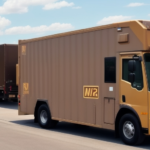How to Get Cheap UPS Shipping Rates: Tips and Strategies
Shipping costs can be a significant expense for businesses of all sizes, especially those that rely on packages and parcels to move their products. If you use UPS for shipping, there are several strategies you can employ to lower your costs and secure affordable UPS shipping rates. In this article, we'll explore these strategies in detail.
Understanding UPS Shipping Rates
The first step in getting cheap UPS shipping rates is to understand how their rates are calculated. UPS rates are based on several factors, including package weight and dimensions, the destination address, and the selected shipping service level. UPS offers a range of service levels, from ground shipping to next-day air, each with different pricing structures.
It's important to note that UPS rates can vary depending on the shipping volume and frequency of your business. Higher shipping volumes and more frequent shipments can often lead to reduced rates on a per-package basis. According to a UPS Supply Chain Report, businesses that optimize their shipping strategies can save up to 15% on their shipping costs.
Another factor that can affect UPS shipping rates is the type of package being shipped. UPS offers different rates for packages that require special handling, such as those that are fragile or hazardous. Additionally, UPS provides discounted rates for certain types of packages, such as bulk shipments or those destined for specific regions.
Finally, it's crucial to consider the timing of your shipments when calculating UPS rates. Shipping during peak seasons, like the holiday season, can result in higher rates due to increased demand. Conversely, shipping during off-peak times may lead to lower rates and faster delivery times.
Negotiating with UPS for Better Shipping Rates
For businesses that ship frequently, negotiating directly with UPS for better rates can be an effective strategy. UPS offers negotiated rates to businesses that meet specific volume and frequency thresholds, and the savings can be significant.
To qualify for negotiated rates, businesses typically need to commit to a certain volume of shipments over a specific period, such as a month or quarter. The exact requirements can vary depending on the business and the UPS service level selected, so it's important to work with a UPS representative to determine the best approach for your business.
Negotiating with UPS requires preparation. Businesses should have a clear understanding of their shipping needs and be able to provide data on their shipping volume and frequency. This information helps UPS representatives determine the best rates and service levels for the business.
In addition to negotiated rates, UPS also offers other cost-saving options for businesses, such as UPS My Choice and UPS Access Point. These services allow customers to choose delivery options that are more convenient and cost-effective, further reducing shipping costs.
How to Calculate Shipping Costs with UPS
Calculating shipping costs with UPS is relatively straightforward. The first step is to measure and weigh your package to determine its dimensions and weight. Next, you can use UPS's online rate calculator or speak with a UPS representative to determine the cost of that shipment based on the selected service level and destination address.
UPS offers several shipping options that can affect the cost of your shipment, including package pickup, insurance coverage, and delivery confirmation. Working with a UPS representative can help ensure you get the best value for your shipping needs.
Another important factor to consider when calculating shipping costs with UPS is the distance between the origin and destination. The farther the package needs to travel, the higher the shipping cost will be. Additionally, the type of item being shipped can also impact the cost. For example, hazardous materials or oversized items may require special handling and incur additional fees.
Tips for Reducing Shipping Costs with UPS
There are several tips and best practices businesses can use to reduce shipping costs with UPS:
- Consolidate packages whenever possible to reduce the number of shipments you make.
- Choose the most cost-effective service level that still meets your business's shipping needs.
- Optimize package dimensions to ensure you're not paying for unnecessary space.
- Take advantage of UPS's pickup service to save time and eliminate the need for additional transportation.
- Use UPS's online tools and resources to streamline your shipping process and reduce administrative costs.
Another way to reduce shipping costs with UPS is to negotiate rates based on your shipping volume. If your business ships a large volume of packages, you may be able to negotiate lower rates with UPS. It's worth reaching out to your UPS representative to discuss your options.
Additionally, consider using UPS's flat-rate shipping options for packages that weigh less than 70 pounds. This can be a cost-effective option for businesses that frequently ship small, lightweight items.
The Importance of Packaging for Lower UPS Shipping Rates
Packaging plays a significant role in the cost of UPS shipping. Proper packaging not only ensures that your shipment arrives safely but can also reduce shipping costs by ensuring packages are compact and minimize wasted space.
When packaging your products, consider using smaller boxes and filling any empty space with packaging materials, such as bubble wrap or packing paper. This can help minimize the size and weight of your package, reducing shipping costs.
In addition to using smaller boxes and filling empty space, you can also consider using lightweight packaging materials. For example, using plastic air pillows instead of heavier materials like foam can significantly reduce the weight of your package, resulting in lower shipping costs.
Another important factor to consider when packaging your products is the type of packaging used. For example, using corrugated cardboard boxes can provide better protection for your products during shipping, reducing the risk of damage and the need for costly returns or replacements.
How to Choose the Right UPS Shipping Service for Your Business Needs
Choosing the right UPS shipping service is critical to ensuring the most cost-effective solution for your business needs. Consider the weight and dimensions of your package, the level of urgency for delivery, and the destination address when selecting a UPS service level.
For example, if speed is critical, selecting a next-day air service may be necessary. On the other hand, if cost is the primary concern, selecting ground shipping may be the better choice.
Another important factor to consider when choosing a UPS shipping service is the level of tracking and insurance offered. If your package contains valuable or sensitive items, it may be worth investing in a service that offers more comprehensive tracking and insurance options.
It's also important to keep in mind any special requirements or restrictions for the destination address. Some UPS services may not be available for certain international destinations or may have specific packaging requirements for hazardous materials.
Using Technology to Optimize Your UPS Shipping Strategy
Technology can play an essential role in optimizing your UPS shipping strategy. Using UPS's online tools and resources, businesses can streamline their shipping process, manage package tracking and delivery, and simplify invoicing and payment processes.
For example, businesses can use UPS's online portal to schedule pickups, track package delivery, and manage invoices and payments. By using these tools, businesses can reduce administrative costs and improve overall shipping efficiency.
In addition to these online tools, UPS also offers advanced analytics and reporting capabilities to help businesses gain insights into their shipping data. By analyzing shipping trends and patterns, businesses can identify areas for improvement and make data-driven decisions to optimize their shipping strategy.
The Benefits of Working with a Third-Party Logistics Provider for UPS Shipping
Working with a third-party logistics provider (3PL) can help businesses reduce shipping costs and improve overall shipping efficiency. 3PLs can often negotiate better rates with UPS due to their shipping volume and expertise, and can provide additional services, such as warehousing and inventory management.
Additionally, working with a 3PL can help businesses reduce administrative costs associated with shipping and streamline the entire process. However, it's essential to select a reputable and experienced 3PL partner to ensure the best results.
Common Mistakes to Avoid When Trying to Get Cheap UPS Shipping Rates
When trying to get cheap UPS shipping rates, there are several common mistakes businesses should avoid:
- Choosing the wrong service level for their needs, resulting in unnecessary costs.
- Ignoring packaging and using oversized boxes or packing materials, resulting in higher shipping costs.
- Failing to negotiate with UPS or explore alternative shipping options.
- Overlooking the importance of administrative and tracking tools, resulting in higher administrative costs and inefficiency.
How to Track Your Packages and Manage Your UPS Account Online
UPS offers several online tools and resources to help businesses track their packages and manage their UPS account. Using the My UPS online portal, businesses can schedule pickups, track packages in real-time, manage invoices and payments, and access a range of other shipping-related tools and information.
By utilizing these tools, businesses can improve overall shipping efficiency and reduce administrative costs associated with shipping.
Maximizing Savings with Discounts and Promotions on UPS Shipping
Businesses can save money on UPS shipping by taking advantage of discounts and promotions offered by UPS. These discounts can include volume-based pricing, seasonal promotions, and other special offers that can help reduce shipping costs.
Businesses should regularly check for discounts and promotions on UPS shipping to ensure they're taking full advantage of available cost savings. Subscribing to UPS newsletters or working closely with a UPS representative can help businesses stay informed about the latest offers.
Understanding the Impact of Fuel Surcharges on Your UPS Shipping Costs
Fuel surcharges are an additional cost to consider when shipping with UPS. These surcharges are tied to the fluctuating cost of fuel and can affect the overall cost of shipping, especially for longer distances or heavier packages.
Businesses should be aware of fuel surcharges and factor them into their shipping cost calculations to ensure they're accurately forecasting shipping costs. Monitoring fuel price trends can also help businesses anticipate changes in shipping costs.
How to Effectively Manage Returns and Refunds with UPS
Managing returns and refunds with UPS is crucial for ensuring customer satisfaction and reducing overall shipping costs. UPS offers several tools and resources to help businesses manage returns and refunds, including online tracking and management tools.
By effectively managing returns and refunds, businesses can improve overall customer satisfaction and reduce waste and inefficiency in their shipping process. Implementing a streamlined return policy and utilizing UPS's return services can enhance the customer experience and optimize operational efficiency.
Using Analytics to Evaluate and Improve Your Overall UPS Shipping Performance
Businesses can use analytics and metrics to evaluate their overall UPS shipping performance and identify areas for improvement. UPS offers several tools and resources to track and analyze shipping data, including measuring package delivery times, analyzing shipping volume, and identifying overall shipping costs and trends.
By leveraging these analytical tools, businesses can improve their shipping processes over time, reduce costs, and enhance overall efficiency. Regularly reviewing shipping performance data allows businesses to make informed decisions and continuously optimize their shipping strategies.
Conclusion
By understanding how UPS shipping rates are calculated and leveraging these tips and strategies, businesses can effectively reduce their shipping costs and secure affordable UPS shipping rates. From negotiating directly with UPS to choosing the right shipping service level and utilizing online tools and resources, there are numerous ways to optimize your shipping process and maximize cost savings.






















